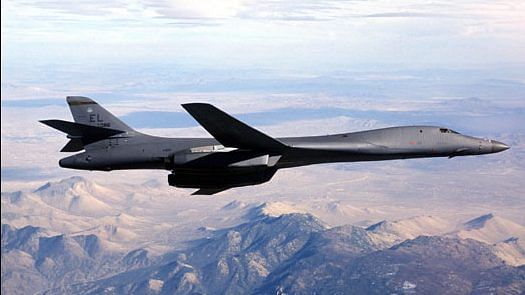New Delhi: The US B-1B long range heavy bomber, capable of carrying payloads up to 35,000 kilos, is set to perform a ‘fly-by’ at the Aero India 2021 that is slated to be held in the coming week at the Yelahanka Air Force Station in Bengaluru.
While the Aero India will showcase the best of the best from India as well as global aviation systems, one of the highlights will be the B-1B Lancer heavy bomber of the 28th Bomb Wing based out of Ellsworth Air Force Base in South Dakota, which will perform a fly-by.
Aero India will be held between 3-5 February and will be the first air show to be held in the world since the Covid-19 pandemic hit.
Backbone of long-range bomber force
The B-1B is the backbone of America’s long-range bomber force and can deliver massive quantities of precision and non-precision weapons against any adversary anywhere across the world.
The aircraft’s blended wing/body configuration, variable-geometry wings and turbofan afterburning engines help the bomber fly over long ranges with precision and high speed.
Its forward wing settings are used for takeoffs, landings, air refuelling and in some high-altitude weapons employment scenarios.
Nearly 50 world records
The B-1B also holds nearly 50 world records for speed, payload, range, and time of climb in its class. The 146-foot-long bomber aircraft has a wingspan of 137 feet.
Until 2007, the B-1B was considered a heavy bomber equipped for nuclear armament. It was only after the Strategic Arms Reduction Treaty that physical changes were made to the bomber to make it a conventional payload specialist.
Priced at USD 317 million a unit, the aircraft, with its Global Positioning System-aided Inertial Navigation System, can navigate without the aid of ground-based assets as well as engage targets with a high level of precision.
The B-1A was initially developed in the 1970s, but major improvements to its structure were made, and its revamped variant was initiated by the Ronald Reagan administration in 1981.
Also read: India’s defence needs money. If Budget can’t provide it, we need to change how we fight




To begin with, I look forward to a time when India will own such a bomber. We donate so many engineers and scientists who probably work on these products. But, India seems to have run out of talent when it comes to designing and manufacture of these weapons systems. That sanctions come in the way of procurement of engines, other systems from abroad sound like lame excuses. If others can develop such subsystems, why can’t India too do it? I have the answer. In the early 1980s, India neglected electronic industries and lost the race. We don’t make high density ICs in India.
Just the facts:
The B-1B “BONE” isn’t and has never been the “backbone” of the US bomber fleet. That would be the B-52 “BUFF”. The B-1’s MRR (mission readiness rates) have been dismal, throughout the life of the program. She is pretty sexy-looking but operational performance is the only thing that really matters. Routine and extended periods of groundings, aircrews going non-current, exorbitant repair and maintenance costs, etc. At times, out of the 100 aircraft acquired, there have been as few as 1 or 2 aircraft actually capable of performing the mission. Retiring the the B-1 can’t come fast enough for the USAF. Plagued with with so many problems since inception, she has been ready for the BONEyard since Day-1.
On the other hand, the B-52, along with her air and maintenance crews have established an incredible record of operational performance. 1950s technology, adapted from it original design as a high-altitude, strategic bomber to a low-level tactical bomber has been and still is the backbone of the bomber fleet. The USAF will continue to rely on the BUFF as the mainstay of the bomber force long after the Lancer has been retired in a few years.